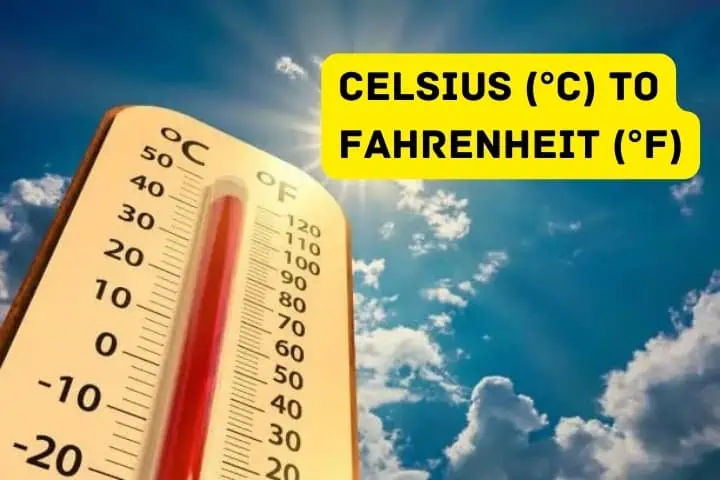
Do you often find yourself confused when it comes to temperature conversions between Celsius and Fahrenheit? Well, you’re not alone. Many people (including me 😅) often struggle to figure out the exact measurements in different temperature scales. So, let’s dive into the explanation of what’s 180degrees celsius to fahrenheit and Converting 180 degrees Celsius (°C) to Fahrenheit (°F).
What’s 180 Degrees C in Fahrenheit & Converting 180°C to Fahrenheit
To convert Celsius to Fahrenheit, you can use a simple formula: multiply the Celsius temperature by 9/5 and then add 32. So, if we apply this formula to 180 degrees Celsius:
Formula (180°C × 9/5) + 32 = 356°F
Therefore, 180 degrees Celsius is equal to 356 degrees Fahrenheit. Keep in mind that the Fahrenheit scale is commonly used in the United States, while Celsius is the standard unit of temperature measurement in many other countries.
Now that you know how to convert temperatures between these two scales, you can easily compare and communicate temperatures across different regions or when using various devices that display temperatures in different units.
Explanation of the formula and its components
Converting Celsius to Fahrenheit is a common task when dealing with temperature measurements. The formula for converting Celsius to Fahrenheit is:
T (°F) = T (°C) × 9/5 + 32
Let’s understand the components of this formula:
- T (°F): This represents the Temperature in Fahrenheit.
- T (°C): This represents the Temperature in Celsius.
To convert Celsius to Fahrenheit, you need to multiply the temperature in Celsius by 9/5 and then add 32 to the result.
For example, if you have a temperature of 180 degrees Celsius and you want to convert it to Fahrenheit, you would use the formula:
T(°F) = 180 × 9/5 + 32
Simplifying this equation, you get:
T(°F) = 356 + 32
T(°F) = 356
Therefore, 180 degrees Celsius is equal to 356 degrees Fahrenheit.
Reverse Formula
(356°F − 32) × 5/9 = 180°C
Converting temperatures from one scale to another is essential when working with international measurements or when communicating with individuals who use different systems of measurement.
By understanding and applying the formula for converting Celsius to Fahrenheit, you can easily make accurate conversions and communicate temperature values effectively.
Converting 180 degrees Celsius to Fahrenheit
Here step-by-step calculation for converting 180degrees celsius to fahrenheit. Converting temperatures from Celsius to Fahrenheit and vice versa is a common task, especially in scientific and cooking contexts. If you have a temperature of 180 degrees Celsius and need to convert it to Fahrenheit, here’s the step-by-step calculation:
- Start by multiplying the Celsius temperature by 9/5.
- 180 x 9/5 = 324
- Next, add 32 to the result from step one.
- 324 + 32 = 356
Therefore, 180 degrees Celsius is equivalent to 356 degrees Fahrenheit.
It’s important to note that the Fahrenheit and Celsius scales measure temperature differently. While both scales are used around the world, the Celsius scale is more commonly used in most countries, including scientific research and everyday applications.
Understanding temperature conversions allows for better understanding and communication. Whether you’re following a recipe with different temperature units or interpreting scientific data, being able to convert between Celsius and Fahrenheit provides you with flexibility and accuracy.
Examples of situations where knowing temperature conversions can be helpful
- Traveling: Understanding temperature conversions helps you prepare for different climates in other countries.
- Cooking: Many recipes require specific temperature settings, and knowing the conversions ensures accurate cooking.
- Health: Knowing the temperature conversions allows you to understand fever or body temperature measurements accurately.
- Science and Engineering: Conversion between Celsius and Fahrenheit is crucial for certain scientific experiments and engineering calculations.
By having a good grasp of temperature conversions, you can navigate these situations with ease and avoid any confusion or errors.
Examples of temperatures in both Celsius and Fahrenheit for easy comparison
When it comes to temperature, it’s helpful to understand the relationship between Celsius and Fahrenheit. One of the common reference points is 180 degrees Celsius, which is equivalent to 356 degrees Fahrenheit.
To put it into perspective, here are a few examples of temperatures in both Celsius and Fahrenheit:
- Freezing point of water: 0 degrees Celsius (0°C × 9/5) + 32 = 32°F
- Room temperature: 20 degrees Celsius (20°C × 9/5) + 32 = 68°F
- Boiling point of water: 100 degrees Celsius (100°C × 9/5) + 32 = 212°F
- Human body temperature: 37 degrees Celsius (37°C × 9/5) + 32 = 98.6°F
- What is 18 degrees c in fahrenheit (18°C × 9/5) + 32 = 64.4°F
Understanding these reference points can be useful in everyday situations, especially when traveling or cooking. It allows you to easily convert temperatures between the two measurement systems and ensures that you have the correct settings for various activities.
So, the next time you come across a temperature of 180 degrees Celsius, you can quickly convert it to Fahrenheit and understand that it is equivalent to 356 degrees. Being familiar with these conversions will make your life easier and help you make accurate decisions based on the temperature.
FAQ (Frequently Asked Questions)
Common questions about temperature conversions and their answers. Below are answers to some common questions about temperature conversions, specifically relating to the conversion of Celsius to Fahrenheit:
Q.1: What is 180degrees celsius to fahrenheit?
A.1: To convert Celsius to Fahrenheit, you can use the formula: Fahrenheit = 1.8 * Celsius + 32.
Using this formula, 180 degrees Celsius can be converted to Fahrenheit as follows:
Fahrenheit = 1.8 * 180 + 32
= 324 + 32
= 356 degrees Fahrenheit.
Q.2 Why do we use different temperature scales?
Different regions and countries around the world use different temperature scales for historical, cultural, or scientific reasons. The Celsius scale is commonly used in most parts of the world for everyday temperature measurements, while the Fahrenheit scale is primarily used in the United States and a few other countries.
Q.3 Can I use an online temperature conversion tool?
A.3 Yes, there are many online temperature conversion tools available that can quickly and accurately convert temperatures between Celsius and Fahrenheit. These tools can be helpful if you need to perform multiple conversions or are unsure of the conversion formula.
Conclusion
In conclusion, understanding temperature conversions is essential for various aspects of daily life and professional fields.
The ability to convert between Celsius and Fahrenheit measurements allows for better comprehension and communication of temperature-related information.
Whether you are cooking, traveling to a different country, or working in scientific research, having a grasp of these conversions is key.
To recap:
- Celsius and Fahrenheit are two commonly used temperature scales.
- The boiling point of water is 100 degrees Celsius or 212 degrees Fahrenheit.
- The freezing point of water is 0 degrees Celsius or 32 degrees Fahrenheit.
- To convert Celsius to Fahrenheit, multiply the temperature by 9/5 and add 32.
- To convert Fahrenheit to Celsius, subtract 32 from the temperature and multiply by 5/9.
By understanding these conversions, you can ensure accurate temperature readings, follow recipes correctly, and adapt to different climate conditions. It is crucial for professionals in fields such as meteorology, culinary arts, and healthcare to have a solid understanding of temperature conversions to carry out their work effectively.
So, whether it’s converting temperatures for everyday activities or professional purposes, having this knowledge will undoubtedly prove useful in various situations.
Also read:


